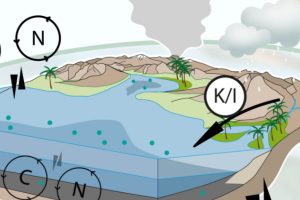Mathilde Mercuzot PhD thesis
 Palaeoenvironmental and palaeoclimatic reconstitutions in late-orogenic setting: the end-Carboniferous to Permian basins of the north-eastern Massif Central France
Palaeoenvironmental and palaeoclimatic reconstitutions in late-orogenic setting: the end-Carboniferous to Permian basins of the north-eastern Massif Central France
Defended on the 9th October 2020
Funding: BRGM and Région Bretagne
Supervisors: Sylvie Bourquin (supervisor, Géosciences Rennes) ; Anne-Catherine Pierson-Wickmann (cosupervisor, Géosciences Rennes) ; Laurent Beccaletto (BRGM Orléans) ; Pierre Pellenard (Biogéosciences Dijon)
Started in october 2017
Abstract
The end of the Palaeozoic is witness to major internal and external geodynamic modifications, materialised both by the end of the accretion of Pangaea and the beginning of its dismantling, and by a major climatic transition, from an icehouse to a greenhouse mode on a vegetated Earth, with a structuring of the biosphere analogous to the present one. Given these major modifications, palaeoenvironmental changes are recorded in the late Carboniferous to Permian late-orogenic sedimentary basins, such as in Western Europe, and particularly in France, in the north-eastern part of the Massif Central constituting a remnant of the Variscan orogeny. At present, these basins are difficult to study because of their incomplete preservation, and are mainly available through subsurface data, with rare outcrops. In addition, the geochronological framework in which they occur is relatively unconstrained.
This work aims at re-evaluating all available data: the first step was to improve the geochronological framework of the sedimentary series by U-Pb dating on altered volcanic ash layers interbedded in siliciclastic sediments, in order to accurately place these basins in the geodynamic context. Obtained ages are centered on the Carboniferous-Permian boundary and the early Permian. The sedimentological setting was then clarified, highlighting mainly subaquatic (lakes and deltas) and sometimes subaerial deposits (floodplains), with well-preserved coal and organic matter-rich levels, indicating a relatively humid climate. A more developed study on organic matter clarified the depositional environment evolution and highlighted local perturbations in carbon and nitrogen cycles. Mineralogical characterisation of clay assemblages highlighted local variations in continental runoff over time. Finally, to characterise the high-frequency temporal framework, a cyclostratigraphic study was carried out, highlighting an astronomical-cycle control on the sedimentation, placing basin filling processes in a larger-scale climatic setting.
Reference sections are now available for the Carboniferous–Permian transition in the Western European continental realm, studied using a multi-proxy approach, the results of which reflect local to global-scale palaoenvironmental and palaeoclimatic conditions.
Keywords
Carboniferous, Permian, paleoenvironments, paleoclimates, carbon
- extrait:
- lien_externe:
- titre:
- Reconstitutions paléoenvironnementales et paléoclimatiques en contexte tardi-orogénique : cas des bassins fini-carbonifères à permiens du nord-est du Massif central, France
- date_de_debut_these:
- nom:
- Mercuzot
- date_de_debut_these_numerique:
- 20171001
- kc_data:
- a:8:{i:0;s:0:"";s:4:"mode";s:0:"";s:3:"css";s:0:"";s:9:"max_width";s:0:"";s:7:"classes";s:0:"";s:9:"thumbnail";s:0:"";s:9:"collapsed";s:0:"";s:9:"optimized";s:0:"";}
- kc_raw_content:
 Palaeoenvironmental and palaeoclimatic reconstitutions in late-orogenic setting: the end-Carboniferous to Permian basins of the north-eastern Massif Central France
Palaeoenvironmental and palaeoclimatic reconstitutions in late-orogenic setting: the end-Carboniferous to Permian basins of the north-eastern Massif Central FranceDefended on the 9th October 2020
Funding: BRGM and Région Bretagne
Supervisors: Sylvie Bourquin (supervisor, Géosciences Rennes) ; Anne-Catherine Pierson-Wickmann (cosupervisor, Géosciences Rennes) ; Laurent Beccaletto (BRGM Orléans) ; Pierre Pellenard (Biogéosciences Dijon)
Started in october 2017
Abstract
The end of the Palaeozoic is witness to major internal and external geodynamic modifications, materialised both by the end of the accretion of Pangaea and the beginning of its dismantling, and by a major climatic transition, from an icehouse to a greenhouse mode on a vegetated Earth, with a structuring of the biosphere analogous to the present one. Given these major modifications, palaeoenvironmental changes are recorded in the late Carboniferous to Permian late-orogenic sedimentary basins, such as in Western Europe, and particularly in France, in the north-eastern part of the Massif Central constituting a remnant of the Variscan orogeny. At present, these basins are difficult to study because of their incomplete preservation, and are mainly available through subsurface data, with rare outcrops. In addition, the geochronological framework in which they occur is relatively unconstrained.
This work aims at re-evaluating all available data: the first step was to improve the geochronological framework of the sedimentary series by U-Pb dating on altered volcanic ash layers interbedded in siliciclastic sediments, in order to accurately place these basins in the geodynamic context. Obtained ages are centered on the Carboniferous-Permian boundary and the early Permian. The sedimentological setting was then clarified, highlighting mainly subaquatic (lakes and deltas) and sometimes subaerial deposits (floodplains), with well-preserved coal and organic matter-rich levels, indicating a relatively humid climate. A more developed study on organic matter clarified the depositional environment evolution and highlighted local perturbations in carbon and nitrogen cycles. Mineralogical characterisation of clay assemblages highlighted local variations in continental runoff over time. Finally, to characterise the high-frequency temporal framework, a cyclostratigraphic study was carried out, highlighting an astronomical-cycle control on the sedimentation, placing basin filling processes in a larger-scale climatic setting.
Reference sections are now available for the Carboniferous–Permian transition in the Western European continental realm, studied using a multi-proxy approach, the results of which reflect local to global-scale palaoenvironmental and palaeoclimatic conditions.
Keywords
Carboniferous, Permian, paleoenvironments, paleoclimates, carbon
